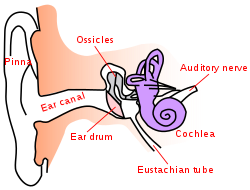Ear canal
| External acoustic meatus | |
|---|---|

Anatomy of the human ear.
|
|
| Details | |
| Precursor | groove (cleft) of the first branchial arch. |
| Artery | anterior part: superficial temporal artery posterior part: posterior auricular artery |
| Vein | superficial temporal veins, external jugular vein, pterygoid plexus |
| Nerve | auriculotemporal nerve, great auricular nerve, auricular branch of vagus nerve |
| Lymph | superficial cervical lymph nodes, deep cervical lymph nodes |
| Identifiers | |
| Latin | meatus acusticus externus |
| Dorlands /Elsevier |
m_06/12518132 |
| TA | A15.3.01.045 |
| FMA | 61734 |
|
Anatomical terminology
[]
|
|
The ear canal (external acoustic meatus, external auditory meatus, EAM) (Latin: meatus acusticus externus), is a tube running from the outer ear to the middle ear. The adult human ear canal extends from the pinna to the eardrum and is about 2.5 centimetres (1 in) in length and 0.7 centimetres (0.3 in) in diameter.
The human ear canal is divided into two parts. The elastic cartilage part forms the outer third of the canal; its anterior and lower wall are cartilaginous, whereas its superior and back wall are fibrous. The cartilage is the continuation of the cartilage framework of pinna. The bony part forms the inner two thirds. The bony part is much shorter in children and is only a ring (annulus tympanicus) in the newborn.
Size and shape of the canal vary among individuals. The canal is approximately 2.5 centimetres (1 in) long and 0.7 centimetres (0.28 in) in diameter. It has a and runs from behind and above downward and forward. On the cross-section, it is of oval shape. These are important factors to consider when fitting earplugs.
Due to its relative exposure to the outside world, the ear canal is susceptible to diseases and other disorders. Some disorders include:
Earwax, also known as cerumen, is a yellowish, waxy substance secreted in the ear canals. It plays an important role in the human ear canal, assisting in cleaning and lubrication, and also provides some protection from bacteria, fungi, and insects. Excess or impacted cerumen can press against the eardrum and/or occlude the external auditory canal and impair hearing, causing conductive hearing loss.
Base of skull. Inferior surface.
Left infratemporal fossa.
External and middle ear, opened from the front. Right side.
Horizontal section through left ear; upper half of section.
Lateral head anatomy detail.Facial nerve dissection.
...
Wikipedia
